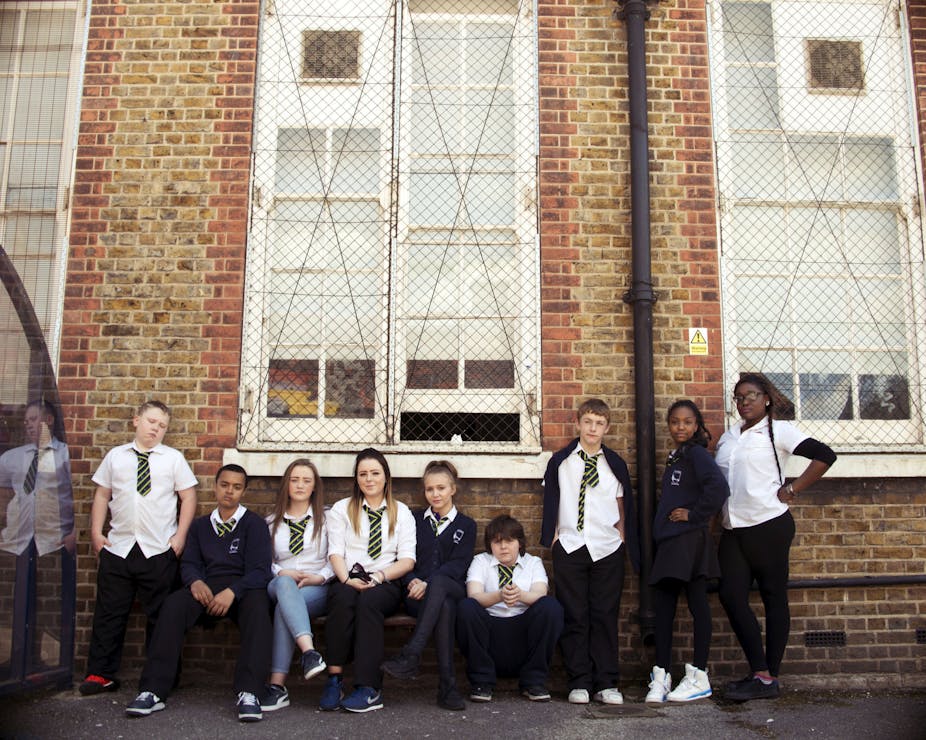In 2013, 3,900 young people were permanently excluded from secondary schools in England. The most common reason for these children to be removed from the mainstream school system was persistent disruptive behaviour. Many of these children will go on to attend Pupil Referral Units (PRUs), which have the challenging task of delivering an academic curriculum for pupils with complex learning and social needs, many of who have extreme behavioural problems.
A new BBC Three documentary series, Excluded: Kicked out of School, provides a look inside one of the country’s largest secondary-level PRUs: The Bridge AP Academy in Hammersmith. Based on a year of filming at the school, the series gives pupils’ own accounts of school life and its challenges. What emerges is a picture of young people living in complex and often disturbing circumstances.
Who gets excluded?
While the background varies for each excluded child, there are some clear trends emerging regarding who gets excluded from schools and so who is likely to attend a PRU.
Family income is a significant factor. Children eligible for free school meals are four times more likely to be permanently excluded than their peers, and three times more likely to be excluded for fixed periods. Ethnicity is also significant, with Black Caribbean pupils nearly four times as likely to be permanently excluded. Boys are three times as likely as girls to be excluded and are also more likely to be excluded from school for fixed periods – meaning they are excluded but remain on the school register.
But more significant than any of these characteristics is having any form of special educational needs: these pupils account for seven in ten permanent exclusions. Although most of these pupils are excluded for behavioural problems, that is not the only reason.
What is a PRU
PRUs were first introduced in England and Wales in 1994 as a form of alternative educational provision for children who could not attend a mainstream school, due to exclusion or medical needs. Between 1999 and 2009, the number of pupils attending PRUs doubled to 15,370 and they have become the most common form of alternative provision, with 450 PRUs distributed across 95% of local authorities.
A decade ago, Labour government policies increasingly advocated “inclusive education” through which all children would attend their local mainstream school. But the number of pupils attending PRUs during this period actually created an increase in the percentage of children attending schools in non-mainstream settings.
In recent years, PRUs have been applying for academy status as “AP Academies”. These are charitable companies, limited by guarantee, with the possibility of being managed by a sponsor – such as a school, charity, faith community or business. The Bridge AP Academy, for example, is part of The Tri-borough Alternative Provision, a multi-academy trust.
Intention to reintegrate
Because PRUs cater for so many pupils with special educational needs and do not need to follow the full national curriculum, they can be seen as a form of special school.
But in the BBC Three series, we see that pupils at The Bridge still take formal examinations and there is an expectation that the children will get five GCSEs. But nationally there is a concern that a large number of pupils leave PRUs without achieving meaningful qualifications.
The majority of pupils attending a PRU have been excluded from school or have been transferred to a PRU as part of a “managed move” because their behaviour persistently disrupted the education of other students.
This move to alternative provision is not intended to be permanent. Instead, the aim is that with support, some students can be integrated back into mainstream schools. But in reality, many young people will remain in PRUs for significant parts of their school lives.
Flexible curriculum
One issue affecting re-integration, identified in a National Union of Teachers survey, is the inflexibility of the curriculum in mainstream schools. By contrast, the curriculum flexibility of many PRUs can support educational experiences that might not fit into more rigid curricula, and create space for building on pupils’ personal interests.
Recent research has shown that PRU teachers who have moved there from mainstream schools, have reported valuing the creativity that is possible outside of these mainstream constraints. They also felt that, although challenging, their PRU work had a stronger “moral purpose”. Both children and teachers have reported the importance of persistent personal relationships in creating positive PRU experiences.
It is worth emphasising that many children labelled as having behavioural, emotional and social difficulties are educated in mainstream schools. And the most recently available data shows that there were 1,000 fewer permanent exclusions in 2012-13 compared to 2009-2010.
But this positive trend must be seen in the context of research indicating numerous “illegal exclusions” – in which parents are asked to keep their children away from school, but not given an official notification of an exclusion. This has revealed a continued tension between national targets to keep pupils in mainstream school and the capacity of the schools to keep them there. In light of this, it looks like the PRUs are here to stay.
Next read: It’s good TV, but most excluded boys can’t afford Mr Drew’s summer school

